
In botany, a bulb is structurally a short stem with fleshy leaves or leaf bases that function as food storage organs during dormancy.
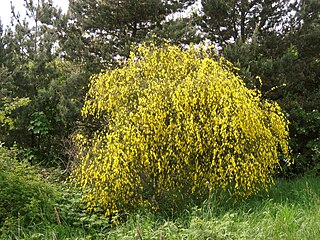
A shrub is a small- to medium-sized perennial woody plant. Unlike herbaceous plants, shrubs have persistent woody stems above the ground. Shrubs can be deciduous or evergreen. They are distinguished from trees by their multiple stems and shorter height, less than 6–10 m (20–33 ft) tall. Small shrubs, less than 2 m (6.6 ft) tall are sometimes termed subshrubs.

In the fields of horticulture and botany, the term deciduous means "falling off at maturity" and "tending to fall off", in reference to trees and shrubs that seasonally shed leaves, usually in the autumn; to the shedding of petals, after flowering; and to the shedding of ripe fruit. The antonym of deciduous in the botanical sense is evergreen.
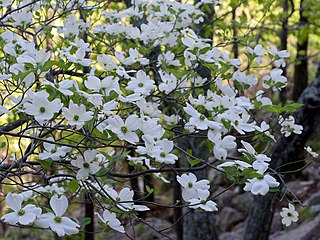
Cornus florida, the flowering dogwood, is a species of flowering tree in the family Cornaceae native to eastern North America and northern Mexico. An endemic population once spanned from southernmost coastal Maine south to northern Florida and west to the Mississippi River. The tree is commonly planted as an ornamental in residential and public areas because of its showy bracts and interesting bark structure.
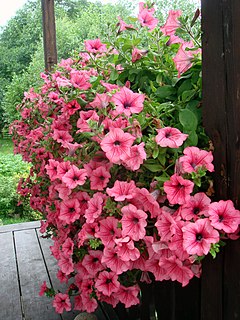
Ornamental plants are plants that are grown for decorative purposes in gardens and landscape design projects, as houseplants, cut flowers and specimen display. The cultivation of ornamental plants comes under floriculture and tree nurseries, which is a major branch of horticulture.

Calluna vulgaris, common heather, ling, or simply heather, is the sole species in the genus Calluna in the flowering plant family Ericaceae. It is a low-growing evergreen shrub growing to 20 to 50 centimetres tall, or rarely to 1 metre (39 in) and taller, and is found widely in Europe and Asia Minor on acidic soils in open sunny situations and in moderate shade. It is the dominant plant in most heathland and moorland in Europe, and in some bog vegetation and acidic pine and oak woodland. It is tolerant of grazing and regenerates following occasional burning, and is often managed in nature reserves and grouse moors by sheep or cattle grazing, and also by light burning.

Cota tinctoria, the golden marguerite, yellow chamomile, or oxeye chamomile, is a species of perennial flowering plant in the sunflower family. Other common names include dyer's chamomile, Boston daisy, and Paris daisy. In horticulture this plant is still widely referred to by its synonym Anthemis tinctoria.
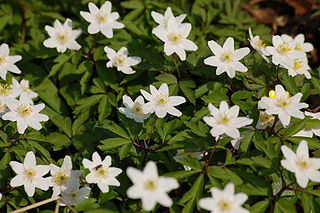
Anemonoides nemorosa, the wood anemone, is an early-spring flowering plant in the buttercup family Ranunculaceae, native to Europe. Other common names include windflower, thimbleweed, and smell fox, an allusion to the musky smell of the leaves. It is a perennial herbaceous plant growing 5–15 cm (2–6 in) tall.

Floriculture, or flower farming, is a discipline of horticulture concerned with the cultivation of flowering and ornamental plants for gardens and for floristry, comprising the floral industry. The development, via plant breeding, of new varieties is a major occupation of floriculturists.

Prunus cerasifera is a species of plum known by the common names cherry plum and myrobalan plum. It is native to Southeast Europe and Western Asia, and is naturalised in the British Isles and scattered locations in North America. Also naturalized in parts of SE Australia where it is considered to be a mildly invasive weed of bushland near urban centers.

The term color garden has in popular use two contradictory interpretations. A color garden has a variety of colors in it so that it is more attracting. In the first sense, a color garden is a garden specially planted in order to display a wide variety of colors, often in a particular season. In the second sense, a color garden may more accurately be labeled a single-color garden.

Nandina domestica commonly known as nandina, heavenly bamboo or sacred bamboo, is a species of flowering plant in the family Berberidaceae, native to eastern Asia from the Himalayas to Japan. It is the only member of the monotypic genus Nandina. It is widely grown in gardens as an ornamental plant since it has a number of cultivars that display bright-red fall foliage in the cool months with attractive new foliage growth in spring. Although a popular ornamental shrub, the berries are toxic to birds, especially towards the end of the winter when other food sources become scarce.
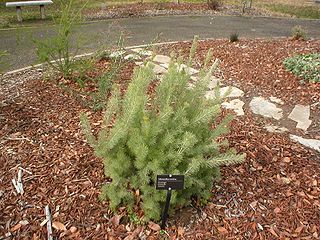
Adenanthos sericeus, commonly known as woolly bush, is a shrub native to the south coast of Western Australia. It has bright red but small and obscure flowers, and very soft, deeply divided, hairy leaves.
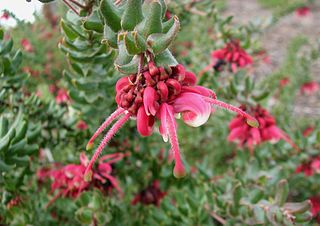
Grevillea baueri, commonly known as Bauer's grevillea, is a low-growing shrub which is endemic to the coastal ranges of south-eastern New South Wales in Australia. It usually grows up to 1 metre in height and 2 metres in width. Flowers are produced in late winter and spring. These have a red perianth with a cream tip and a green-tipped red style.

Grevillea asparagoides is a shrub which is endemic to the south-west of Western Australia. It grows up from 0.5 to 2 metres in height and produces bright red flowers between July and December in its native range.

Rosa 'Garden Party' is an ivory hybrid tea rose cultivar created by Herbert C. Swim in 1959. Its parents are the hybrid teas 'Charlotte Armstrong' and 'Peace'.

Grevillea shiressii is an Australian shrub of the family Proteaceae endemic to New South Wales, where it is found in only two localities near Gosford.

Persoonia chamaepitys, commonly known as the prostrate- or mountain geebung, is a shrub endemic to New South Wales in eastern Australia. It has a prostrate habit, reaching only 20 cm (7.9 in) high but spreading up to 2 m (6.6 ft) across, with bright green spine-like leaves and small yellow flowers appearing in summer and autumn.

Senegalia nigrescens, the knobthorn, is a deciduous African tree, growing up to 18 m tall, that is found in savanna regions from West Africa to South Africa. The tree is resistant to drought, not resistant to frost and its hard wood is resistant to termites. Giraffes often browse on the flowers and foliage of this tree, while the seed pods and foliage are browsed on by a range of mammals, including elephants.






















